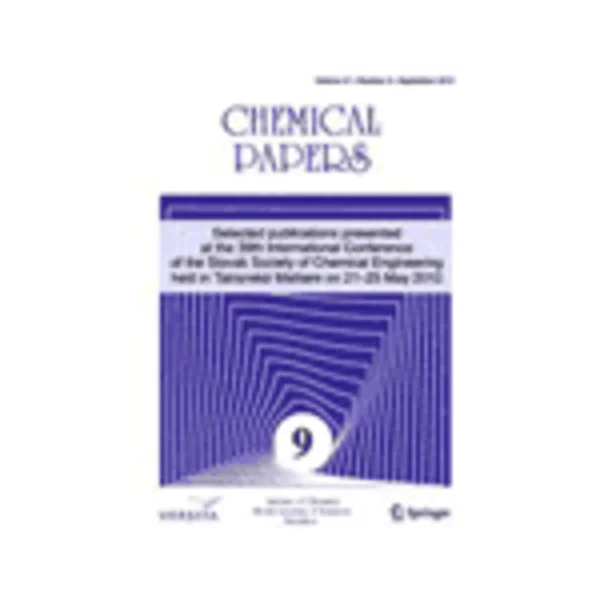-
solubility and micronisation of phenacetin in supercritical carbon dioxide
جزئیات بیشتر مقاله- تاریخ ارائه: 1392/07/24
- تاریخ انتشار در تی پی بین: 1392/07/24
- تعداد بازدید: 836
- تعداد پرسش و پاسخ ها: 0
- شماره تماس دبیرخانه رویداد: -
the rapid expansion of a supercritical solution (ress) process represents an attractive prospect for producing sub-micron and nano-particles of medical compounds with low solubility. the solubility of phenacetin in supercritical carbon dioxide was measured by the analytical-isothermal method at pressures ranging from 9.0 mpa to 30.0 mpa and temperatures ranging from 308.0 k to 328.0 k. the results show that the mole fraction solubility of phenacetin in supercritical carbon dioxide is up to 10−5. four density-based semi-empirical models were introduced to correlate the experimental data. agreement between the model predictions and experimental data is greater with the adachi-lu-modified chrastil model than with the chrastil model, méndez-santiago-teja model, and the bartle model and the average absolute relative deviation (aard) observed is 0.0483. the preparation of fine phenacetin particles by the ress process under different conditions of extraction temperatures (308.0–328.0 k), extraction pressures (9.0–30.0 mpa), nozzle temperatures (373.0–393.0 k), nozzle diameters (0.1–0.8 mm), and collection distance (20.0–40.0 mm) was investigated. the size and morphology of the resultant particles were analysed by sem. a remarkable modification in size and morphology can be obtained by condition-optimisation.
مقالات جدیدترین رویدادها
-
استفاده از تحلیل اهمیت-عملکرد در ارائه الگوی مدیریت خلاقیت سازمانی و ارائه راهکار جهت بهبود
-
بررسی تاثیر ارزش وجوه نقد مازاد بر ساختار سرمایه شرکت های پذیرفته شده در بورس اوراق بهادار تهران
-
بررسی تأثیر سطح افشای ریسک بر قرارداد بدهی شرکت های پذیرفته شده در بورس اوراق بهادار تهران
-
بررسی تأثیر رتبه بندی اعتباری مبتنی بر مدل امتیاز بازار نوظهور بر نقد شوندگی سهام با تأکید بر خصوصی سازی شرکت ها
-
تأثیر آمیخته بازاریابی پوشاک ایرانی بر تصویر ذهنی مشتری پوشاک ایرانی (هاکوپیان)
-
تعیین رابطه پره اکلامپسی با دی دایمر در زنان باردار
-
بررسی تاثیر ابعاد، موقعیت و شکل بازشوها بر رفتار سقف های دال بتی دوطرفه
-
بررسی تاثیر منابع معنوی بر عملکرد مالی سازمان با در نظر گرفتن اثر میانجی فرآیند و عملکرد هیات مدیره (مورد مطالعه: شرکت خدمات ارتباطی مخابراتی رایتل)
-
میزان انعکاس مسایل تربیت دینی در کتاب فارسی هفتم از منظر دبیران ادبیات فارسی دوره ی اول متوسطه دخترانه شهرستان مرند
-
effect of various nanoclay on the reological behavior of bitumen
مقالات جدیدترین ژورنال ها
-
مدیریت و بررسی افسردگی دانش آموزان دختر مقطع متوسطه دوم در دروان کرونا در شهرستان دزفول
-
مدیریت و بررسی خرد سیاسی در اندیشه ی فردوسی در ادب ایران
-
واکاوی و مدیریت توصیفی قلمدان(جاکلیدی)ضریح در موزه آستان قدس رضوی
-
بررسی تاثیر خلاقیت، دانش و انگیزه کارکنان بر پیشنهادات نوآورانه کارکنان ( مورد مطالعه: هتل های 3 و 4 ستاره استان کرمان)
-
بررسی تاثیر کیفیت سیستم های اطلاعاتی بر تصمیم گیری موفق در شرکتهای تولیدی استان اصفهان (مورد مطالعه: مدیران شرکتهای تولیدی استان اصفهان)
-
بررسی تاثیر وابستگی و تعهد به رابطه بر برون سپاری فعالیت های لجستیک مورد مطالعه: شهرداری آبیک قزوین
-
واکاوی منابع انسانی در زمینه افزایش انگیزه و کارآیی بهتر در سازمانهای دولتی
-
عوامل موثر در حسابرسی بر تجدید ارائه صورت های مالی شرکت های بورس اوراق بهادار تهران
-
بررسی رابطه بین شهرت حسابرس با مدیریت کفایت سرمایه بانک های پذیرفته شده در بورس اوراق بهادار تهران
-
توزیع بار اقتصادی با در نظر گرفتن آلودگی زیست محیطی در سیستم قدرت با استفاده از الگوریتم چند هدفه مبتنی بر معیار پارتو و منطق فازی




سوال خود را در مورد این مقاله مطرح نمایید :